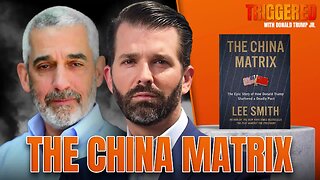Premium Only Content

Ripple Replaces the Fed
Ripple is steady assembling a lawful, auditable, real-time, globally compliant settlement machine …
… so what happens to the Federal Reserve’s opaque, debt-based, interest-slavery machine?
Let’s examine this in four layers:
1. What Ripple has actually built / is building (hard facts)
2. What problems that solves for governments, corporates, and markets
3. What that does to the Fed’s current model of money creation and control
4. The spiritual / lawful implication: sovereignty vs usury.
1. Put simply:
• Ripple Prime = the market access + liquidity layer
• GTreasury = the corporate treasury / cash management layer
• Rail + RLUSD = the instant settlement dollar layer
• Standard Custody / Metaco = the regulated vault & tokenization layer
• OCC bank charter + Fed master account = the legal sovereign banking layer
• XRP Ledger (XRPL), ODL, ILP, AMM = the trustless, programmable, atomic settlement layer
This is a full reserve, always-on, globally compliant, tokenized monetary system.
Not a prototype.
Not a pitch deck.
A system.
2. What problems does this solve for the world?
Problem A. Slow settlement + counterparty risk
International wires and correspondent banking take days, introduce FX slippage, and depend on layers of intermediaries who each take a fee and introduce risk.
Ripple solution:
XRP as a neutral bridge asset and RLUSD as a regulated settlement dollar let two counterparties in two currencies settle atomically — “I get mine only when you get yours.” This kills the “we hope they pay” problem and compresses settlement time from T+2/3 days to seconds, while embedding ISO 20022 data in the payment itself for audit, compliance, and tariffs.
This is irresistible to trade ministries, customs authorities, and corporates trying to manage working capital.
Problem B. Opaqueness in liquidity, collateral, and rehypothecation
The current financial system runs on layers of IOUs. The same collateral (Treasuries, gold, whatever) is pledged multiple times in the shadows of prime brokerage and derivatives markets. That shadow leverage is how systemic crises are born.
Ripple solution:
Ripple Prime + on-ledger custody means collateral, margin, and settlement can all be done with transparent digital records.
If collateral is tokenized and custody is regulated and on-ledger, you cannot secretly pledge the same asset twelve times. The fraud window narrows.
Problem C. Corporate treasury fragmentation
Right now, a multinational’s treasury has to juggle: bank accounts in 20 countries, FX swaps, compliance checks, liquidity pools, overnight sweeps, and manual reconciliation.
Ripple + GTreasury solution:
Plug treasury ops straight into programmable rails, so you can move value, prove reserves, manage FX, and settle invoices instantly in whatever instrument (RLUSD, tokenized cash equivalents, on-ledger gold, XRP bridge liquidity) across 13,000+ banks and hundreds of corporates.
That’s corporate money as software.
Problem D. Regulatory accountability
Regulators (especially now that stablecoins are being pulled under explicit federal rules like the GENIUS Act and ISO 20022 messaging mandates) want provable compliance: who sent what to whom, under what authority, using what asset, with what reserve backing.
Ripple solution:
Every transfer can carry structured data. That satisfies AML/KYC, sanctions screening, tariff enforcement, tax reporting, and settlement finality — in near real time.
This is what governments mean when they talk about “trusted but trustless”: I don’t have to trust you, I can verify you on-chain, and the law can read it.
This is why nations are moving toward bilateral trade agreements that assume DLT settlement, tokenized reserves, and interoperable messaging standards like ISO 20022.
Because you can’t run 21st century global trade on 1970s correspondent banking.
Prognosis: The Fed’s in hospice with no potential for recovery. Death is near.
-
 6:43:40
6:43:40
GritsGG
8 hours agoWorld Record Win Streak Attempt! #1 Most Wins 3880+!
6.87K1 -
 DVR
DVR
Tundra Tactical
5 hours ago $2.33 earnedProfessional Gun Nerd Plays Battlefield 6
30.3K5 -
 1:01:12
1:01:12
Donald Trump Jr.
8 hours agoThe China Matrix with Journalist Lee Smith | TRIGGERED Ep.288
127K83 -

Dr Disrespect
13 hours ago🔴LIVE - DR DISRESPECT - ARC RAIDERS - FULL SEND INTO THE RED
148K17 -
 LIVE
LIVE
JdaDelete
4 hours agoFinally playing Eldin Ring | First Playthrough Episode 2
76 watching -
 1:02:08
1:02:08
BonginoReport
6 hours agoNicki Minaj Speaks Out Against Christian Persecution - Nightly Scroll w/ Hayley Caronia (Ep.169)
59.8K42 -
 5:23:36
5:23:36
HomieQuest
6 hours agoLive Streaming! Pokemon Legends Z-A
2.05K3 -
 5:33:02
5:33:02
FusedAegisTV
9 hours agoFUSEDAEGIS PLAYS THE GREATEST JRPG EVER MADE ⌛► CHRONO TRIGGER (1995) Part 3
2.02K2 -
 2:13:20
2:13:20
Nerdrotic
5 hours ago $2.52 earnedNerdrotic At Night 531
29.9K3 -
 1:43:27
1:43:27
Glenn Greenwald
6 hours agoThe Right's Crusade to Cancel Tucker | SYSTEM UPDATE #542
72.2K87